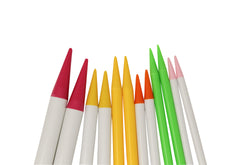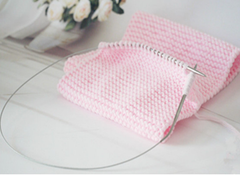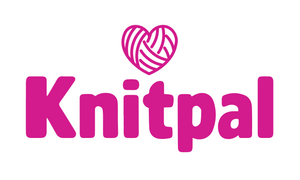
How Different Types of Knitting Needles and Needle Sizes Work
Everyone, when they just start to knit, feel a bit intimidated by the wide variety of knitting needles that are available to use.
That’s why we’ve compiled this quick guide to help you find the perfect knitting needle for your project.
The different types of knitting needles available

There are four main types of knitting needles available:
- Straight or one-pointed knitting needles
- Circular knitting needles (which can also have interchangeable tips and cables, but more about this later)
- Double pointed needles or DPNs
- Cable needles
Knitting needles can be made from a wide variety of materials. Metal, wood, bamboo, and different kinds of plastic are the most common materials that knitting needles are made from.
Each of these materials have their own pros and cons when you’re using different types of yarn as some (like metal) are very slippery while others (like bamboo) tend to be less so.
We’ve found that bamboo knitting needles are a wise choice for those just starting to knit.
Next, we’ll look at how and for kind of knitting each of these types of needles are used.
What the different types of knitting needles are used for
Although some projects are better worked on one specific type of knitting needle, you’ll see in the following explanation that you can sometimes use one type of needle — for instance circulars — for a wide variety of different projects.
Straight Knitting Needles
Also called one-pointed or single-pointed knitting needles, these are the “classic” knitting needle most people and even non-knitters are familiar with.

These straight knitting needles are available in different lengths to accommodate different sized projects. For example, the longer length knitting needles will be used for knitting sweaters and the shorter ones for knitting scarves.
Straight knitting needles come in a large variety of sizes; from the thin size 0 (2 mm) that caters for lace weight yarn, for example, to size 50 that is used with super bulky and jumbo yarn.
While straight knitting needles work great for most projects, they can be too small for knitting shawls, blankets, and the like.
When you’re going to knit socks or other “tubular” shapes, you’ll also need to use either DPNs or circulars.
Straight knitting needles can be a good choice to use when you’re starting out, but if you’re planning on knitting in public — especially in places like public transport — you may rather want to use circular knitting needles as they take up much less space.
Circular knitting needles
Circular knitting needles are needles that are a few inches long and connected to each other by a thin cable.

Some of the circular knitting needles are “interchangeable”, meaning the tips can be unfastened from the cable and placed onto a longer cable, for example, when the work reaches a certain size. The same cable can also be used with various sized tips.
You also get “fixed” circular knitting needles, where the cable and the needle tip are permanently fastened during production.
The sizes the circular needles are available in ranges from the extremely fine size 000 (0.7mm) to size 50. The cables are also available in different lengths — from a few inches to over forty inches.
This means that large shawls and even blankets can be knitted using them.
It’s also important to know that, while circular needles are used to knit “in the round”, you can knit back and forth on the needles as well, just as you would with straight needles.
Double Pointed Needles, on the other hand, is only used to work in the round.
Double Pointed Needles — DPNs
DPNs are sold in sets of four or five needles and, usually, the whole set is used at one time to knit socks, sleeves, etc.
These double pointed needles take more time to get used to and can be very fiddly, especially if you’re working with lightweight yarn like a lace weight or sock yarn.
DPNs are, however, not necessarily needed to knit “in the round” as this can also be done on circular knitting needles as well by using the “magic loop method”.
The sizes that DPNs are available in, are also more limited than the straight and the circular knitting needles. Although they may start at size 000, they will often not be larger than size 10 (6.0 mm).
Cable needles
Cable needles are only used when knitting cables and are not used to knit with on their own. Rather, these needles — which usually looks like a DPN with a kink or a bend in it — are used to hold a few stitches at a time while you knit the cable pattern.
Once you start knitting cables, it’s a good idea to try out the different styles of cable needles to see which of them works the best for you.
Which size knitting needle to use for which yarn
Now that you know which type of knitting needle you’ll use for your project, you just need to figure out which size knitting needle you’ll need.
Usually the band that is on the yarn will not only give you the weight of the yarn — for example, lace weight, aran or worsted — but will also give an indication of the size knitting needle to use with the yarn to get the gauge specified on the band.
However, the following is a good indication of the different yarn weights and needle sizes that are used together.
- Knitting needles sizes 000-1: These are the thinnest needles and are only used for very intricate lace work. Definitely not the needle you want to learn with!
- Knitting needles sizes 1-3: These needles are usually used for socks and fine shawls (using sock or fingering weight yarn).
- Knitting needles sizes 3-5: Used with sport weight yarn, these are perfect for socks, baby blankets, sweaters, and more.
- Knitting needles sizes 5-7: These needles are used for double knitting (DK) yarns. Sweaters, scarves, and gloves are all easily made with DK yarn.
- Knitting needles sizes 7-9:Used with worsted weight yarn, these needles are usually the ones that you learn to knit with because they are easier to handle and the stitches are easy to count.
- Knitting needles sizes 9-11:Bulky and chunky weight yarn goes with these sizes. You’ll see that you’re well on your way to getting jumbo-sized knitting needles and arm knitting.
- Knitting needles larger than size 11: From bulky, to super bulky and jumbo yarns, these are the needles that you need to look for.
All you need now is to decide where you’re going to find a comfortable spot to sit down and start your knitting project!

